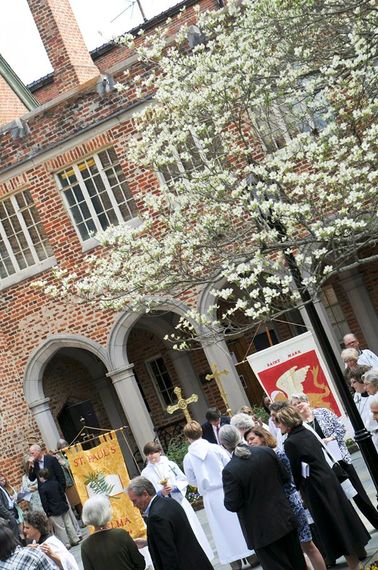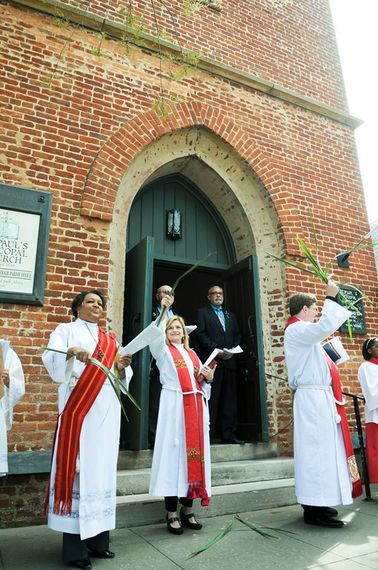On March 14, 1965 -- one week after Bloody Sunday -- a small group of about 19 demonstrators gathered in front of St. Paul's Episcopal Church. Many of them had responded to the Rev. Dr. Martin Luther King's call to come south and participate in the march to Montgomery that would begin the following week. That day, however, their mission was to integrate the historic downtown parish.
These demonstrators didn't carry signs. Instead, they came armed with the Episcopal Church's Book of Common Prayer. After St. Paul's ushers turned them away, the small group knelt at the steps of the church and said a prayer known as the General Confession.
So began the highly charged two-week process that would involve Bishop Carpenter of Alabama, one of the men to whom King had addressed his famous Letter from a Birmingham Jail; Jonathan Daniels, an Episcopal seminarian, now commemorated for his martyrdom in the church's calendar of saints, and a host of others who worked through struggle to accomplish God's vision on earth as it is in heaven. What happened at St. Paul's, where I now serve as rector, seemed so significant at the time that The New York Times published a front-page story when the church was integrated on March 28, 1965.
Much has changed in Selma in 50 years, and the local faith community has taken the lead in trying to bring together a city once defined by its resistance to integration. This past Sunday, Palm Sunday on the Christian calendar, the people of St. Paul's, most of whom are white, joined with the people of St. Mark's, the primarily black Episcopal church in Birmingham to hold a service of reconciliation, to commemorate that Sunday 50 years ago when black and white people worshipped together at St. Paul's and to celebrate a God who uses ordinary women and men to fulfill his plan for justice and peace among all people.
I've had a chance to read some of the first hand accounts of what happened at the church I now serve, and I've been struck by the efforts of my distant predecessor, the Rev. T. Franklin Mathews, and Bishop Carpenter to find a middle path for St. Paul's, to allow black people to worship at the church without endorsing non-violent civil disobedience or alienating Episcopalians in Selma. It is encouraging to watch the tide slowly turn against segregation in these records, but it's also instructive to watch middle ground disappear, and realize that sometimes people in positions of authority can't avoid making all-or-nothing choices.
On March 11, with thousands of people in Selma for the march to Montgomery, St. Paul's vestry, its governing council, met to review its policy on segregation. Mathews reminded the vestry "according to canon law, no communicant or baptized member of The Protestant Episcopal Church in the United States of America should be excluded from the church services." But the vestry would only agree that -- with the exception of Episcopal clergy -- "the admission of any other visitors be left up to the discretion of the ushers."
Mathews told the vestry its amendment was not consistent with the canon, but he honored the vote, and thus, on the 14th, the delegation attempting to integrate the church was turned away. Twenty-five leaders from St. Paul's, including two vestry members, stood in solidarity with those who were not permitted to enter the church.
One member of the delegation later said, "What I remember most about the church visit, however, was the presence of a local lady, elegant and ramrod straight, a member of that parish .... She took on the men with crossed arms and let them know that, if we were forbidden to enter, then she would stand outside with us."
On March 18, Bishop Carpenter received a letter from one of the people who had been turned away from St. Paul's, calling on him to respond to the issue. Two years earlier, Carpenter had joined seven other religions leaders in an open letter calling on King to abandon the tactics of non-violent civil disobedience in his campaign in Birmingham. King's now-famous response cast Carpenter and his co-signer as "ardent defenders of the status quo." But if the bishop bristled at having "outsiders" leading demonstrations in his state, he was no segregationist. He wrote to St. Paul's, urging it to honor the canon.
On March 19th, the vestry convened again but -- in a tie vote -- failed to change its policy. Mathews' vote could have broken the tie, but he was visiting his brother, the Rev. Lex Mathews, in Tallahassee. Lex Mathews' was the chaplain at Florida State University and had helped to integrate the student center there. There is no doubt that the visit strengthened Frank Mathews' resolve to do what he knew was right.
On Sunday March 21, an integrated group of 200 Episcopal clergy and lay people again attempted to enter the church, and again were turned away. The group then returned to Brown Chapel, staging point of the march to Montgomery, and held a service on the sidewalks.
Mathews called another vestry meeting for March 22. This time a motion to obey the canon of the church passed 8-3 with one abstention. Sensing defeat, two vestry members had stayed away. After the vote, two more vestrymen announced their resignations. These men and other parishioners left the parish, taking with them their sizable pledges. Financial struggle and parish conflict, however, were small prices to pay for witnessing to God's truth.
Daniels, a seminarian at what is now Episcopal Divinity School, was among those who worshipped at St. Paul's on March 28. He remained in the area after the famous march, and considered St. Paul's his parish away from home. He was murdered on August 20 in nearby Hayneville when he stepped between a deputy sheriff and a young black woman and took the full force of a shotgun blast.
Over the years, the church became a place that took seriously its call to reconcile all people to God and each other. Perhaps the most significant witness to this truth is that most of the children who attended St. Paul's attended the integrated public school system in Selma. Members of St. Paul's are still committed to a community that works together which was on display at a Unity Walk earlier this month.
When we gathered on Palm Sunday to commemorate the integration of St. Paul's, Lou Willie, a member of St. Mark's who, was nine years old on the day that he was turned away from our doors and Miller Childers, a member of St. Paul's who, was a vestry member who disagreed with parish's policy on segregation, helped calls us to worship. We knelt in a faith that believes in a God who in his good time is making all people one through the reconciling love of Jesus Christ our Lord.
As I heard someone say recently, before we can find common ground we must find holy ground. The Palm Sunday service signified our commitment to find common ground in a faith that believes that God is building up his kingdom right here in Alabama.
The service is available for download at dioala.org.

